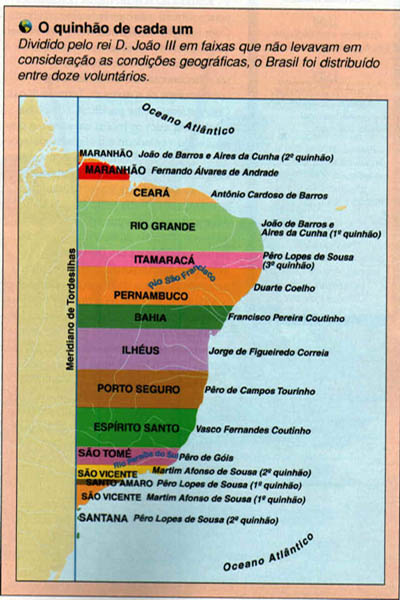|
Ads by Google
Hereditary Capitanies
In 1500, the expansionist Portugal added Brazil to their collection of new lands to be occupied and explored (which included continental and insular African colonies and Easter Asian colonies and trading partners). Portugal was smaller than 100,000 km2, while Brazil had more than 5,000 km of coast (not to mention the unknown massive interior territory); there were just a few million Portuguese, not many of whom were willing to leave one of the central kingdoms in the world to try the fortune in a distant new land, thousands of miles away; furthermore, while the colonies in East Asia were already organized in societies, the dwellers of the New Land were close to savagery, with rudimentar languages and cultures, making it hard to establish reliable relationships.
Portugal had not much interest in diverting human, material and financial resources from their well functioning Eastern Asian colonies to colonize Brazil; however, it was well known that French, British, Dutch and other official and corsary ships were visiting the Brazilian coast; it was necessary to guarantee the possession of the land.
 In 1534, Portugal divided Brazil in Hereditary Capitanies, adopting a system they had already used when colonizing the African colonies (Cabo Verde, São Tomé, Príncipe, Açores, Porto Santo and Madeira).
In 1534, Portugal divided Brazil in Hereditary Capitanies, adopting a system they had already used when colonizing the African colonies (Cabo Verde, São Tomé, Príncipe, Açores, Porto Santo and Madeira).
Each Capitany was a large piece of land, whose administration was granted by the King to a Capitain or Donatary (as the lands were granted in Donation). The Donataries were chosen among the rich men who had not only capital, but experience in the difficult commerce with the Indians; the Donataries were men used to sailing thousand of miles and to negotiating under tough conditions with completely different cultures; they knew the risks undertaken, as well as the huge return potentials.
The Donataries would have no support or guarantees from the King. They would have, however, have civil and criminal jurisdiction over all inhabitants on their capitany (the Portuguese law should apply); they could found villages, nominate ouvidores (the judges of the time) and notaries. They would control which goods would be bought and sold (foreigner commerce, of course, with the metropolis only). Except for a few pre-determined items (like pau-brasil, gold, diamonds and others), they would be exempt from any taxes.
At first, the capitanies would be of hereditary possession, meaning that, once the Donatary died, his descendents would keep the possession. However, because most donataries didn´t have much success, and because later on Portugal noticed that the system as a whole was not working as planned, very soon the hereditary clause was abandoned, and the King reclaimed the power to nominate Capitains at His will.
Initially, Brazil was divided in fifteen capitanies, which were donated to eleven donataries (some
donataries received more than one capitany). All capitanies had as limits the Atlantic Ocean, the line defined by the Treaty of Tordesillas, and two lines paralell to the Equatorial Line. The pic to the right shows the boundaries of the original Capitanies.
The same problems which faced the Portuguese government (scarcity of money and people, long distances, problems with indians and diseases) prevented most capitanies from succeeding; only two of them prospered, both based on the plantation of sugar cane: Pernambuco and São Vicente. Many of the Capitanies were never visited by the Donataries.
Besides the economic failure, soon Portugal noticed that, by lack of resources or lack of will of the donataries, foreigner ships still explored the Brazilian lands. In 1549, Portugal instituted the General Government of Brazil; the capitanies were not extinguished, but their Donataries would report to the the General Governor, instead of reporting to the court in Lisbon; the Governor would be based in Salvador (about middle point of Brazilian coast), visit all capitanies, with autonomy to impose the Royal jurisdiction.
These two systems (capitanies and general government) coexisted until the Independence, in 1822; that year, the capitanies became Provinces (and, eventually, the Provinces became the Brazilian States). Several changes happened over the centuries to separate, agregate and create new capitanies. At the end of their cycle, the map of capitanies was completely different from the original one, but the term "Capitanias Hereditarias" is still used as reference to describe the political division of the colonial Brazil.
Back to Top
|
|
 In 1534, Portugal divided Brazil in Hereditary Capitanies, adopting a system they had already used when colonizing the African colonies (Cabo Verde, São Tomé, Príncipe, Açores, Porto Santo and Madeira).
In 1534, Portugal divided Brazil in Hereditary Capitanies, adopting a system they had already used when colonizing the African colonies (Cabo Verde, São Tomé, Príncipe, Açores, Porto Santo and Madeira).